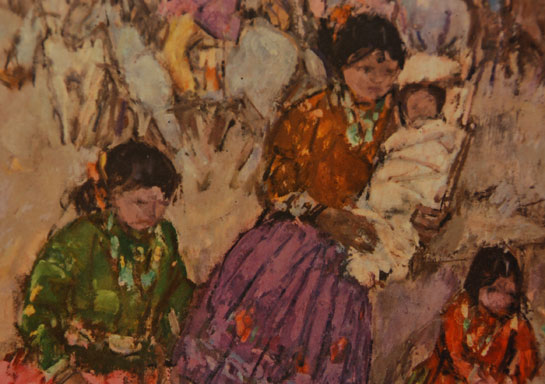"End of the Snake Dance - Oraibi" [SOLD]
+ Add to my watchlist Forward to Friend
- Category: Original Prints
- Origin: Western Artists
- Medium: print on canvas
- Size:
11-3/4” x 17-1/2” image;
15-1/2” x 21-1/4” framed - Item # C3224BK SOLD
In 1918, Leon Gaspard and his wife settled in Taos, New Mexico. A late comer to the art scene in Taos, he was received coolly at first until "Buck" Dunton made him his friend. Painting and traveling, Gaspard was able to establish himself as an important painter of the West.
Gaspard had been born in Russia and was a respected European painter long before he came to America. His first one-man show while still a student in Paris resulted in the purchase of 35 Paris sketches by a New York collector. His successful career in Paris was brought to an end when World War I started and he enlisted in the French Air Corps. He was seriously wounded when he was shot down and he eventually moved to New York City, in 1916. His doctor recommended a warmer climate as being good for his wounds so he and his wife moved to Taos. In Taos, Gaspard was fascinated by the indigenous culture, and set about learning and painting it. His vibrant style was rooted in Impressionism, and resisted many Modernist trends.
Of all the Taos artists of the time, Gaspard's paintings were the most brilliant in color. He had traveled with his dad as a child on fur trades to Asia where he was exposed to colorful clothing and exotic cultures, memories that stayed with him and influenced his paintings throughout his life. His experiences in Taos reminded him of his native Russia and his paintings carried over to the mixed cultures of his life experiences.
This is a print-transfer from an original Gaspard painting to a canvas print. The title of the original painting is "End of the Snake Dance, Oraibi."
Condition: original condition
Provenance: from the collection of Katherine H. Rust
Recommended Reading: TAOS: A Painter's Dream by Patricia Janis Broder and Carl Schaefer Dentzel (Nov 1980)

- Category: Original Prints
- Origin: Western Artists
- Medium: print on canvas
- Size:
11-3/4” x 17-1/2” image;
15-1/2” x 21-1/4” framed - Item # C3224BK SOLD



